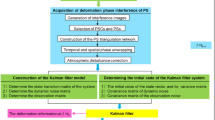Abstract
In recent years, the repeat-pass GBSAR (ground based synthetic aperture radar) system has demonstrated its capacity to acquire deformation. Nevertheless, in a variety of applications, it needs to measure the deformation with the precision up to 0.1 mm, which could not be reached by utilizing the traditional PS (permanent scatterer) algorithm in most cases. Generally, one of the main reasons could be summarized into the phase error caused by the rail determination error, because the precision of rail determination might degrade during long working hours. However, the traditional PS algorithm could not compensate for the phase error caused by the rail determination error. In order to solve the problems, we modify the conventional PS algorithm. Firstly, we deduced the transformation relationship between the rail determination error and its corresponding interferometric phase error. Then, the phase errors caused by the atmosphere and the rail determination error were jointly compensated. The experimental data, which were obtained in Fangshan District in Beijing (China), were used to test and verify the performance of the new algorithm. After the comparison between the results processed by the new algorithm and those processed by the traditional algorithm, the proposed method demonstrated its ability to obtain high-precision deformation.
Similar content being viewed by others
References
Tarchi D, Rudolf H, Pieraccini M, et al. Remote monitoring of buildings using a ground-based SAR: application to cultural heritage survey. Inter Remote Sens, 2000, 21: 3545–3551
Monserrat O, Crosetto M, Luzi G. A review of ground-based SAR interferometry for deformation measurement. ISPRS J Photogramm Remote Sens, 2014, 93: 40–48
Caduff R, Schlunegger F, Kos A, et al. A review of terrestrial radar interferometry for measuring surface change in the geosciences. Earth Surface Process Landforms, 2015, 40: 208–228
Luzi G, Pieraccini M, Mecatti D, et al. Ground-based radar interferometry for landslides monitoring: Atmospheric and instrumental decorrelation sources on experimental data. IEEE Trans Geosci Remote Sens, 2004, 42: 2454–2466
Aguasca A, Broquetas J, Mallorqui J, et al. A solid state L to X-band flexible ground-based SAR system for continuous monitoring applications. In: Proceedings of the IEEE IGARSS, Anchorage, 2004. 757–760
Tarchi D, Casagli N, Fanti R, et al. Landslide monitoring by using ground-based SAR interferometry: an example of application to the Tessina landslide in Italy. Eng Geol, 2003, 68: 15–30
Leva D, Nico G, Tarchi D, et al. Temporal analysis of a landslide by means of a ground-based SAR interferometer. IEEE Trans Geosci Remote Sens, 2003, 41: 745–752
Antonello G, Tarchi D, Casagli N, et al. SAR interferometry from satellite and ground-based system for monitoring deformations on the Stromboli volcano. In: Proceedings of the IEEE IGARSS, Anchorage, 2004. 633–636
Pieraccini M, Casagli N, Luzi G, et al. Landslide monitoring by ground-based radar interferometry: a field test in Valdarno (Italy). Inter Remote Sens, 2003, 24: 1385–1391
Pieraccini M, Luzi G, Mecatti D, et al. Ground-based SAR for short and long term monitoring of unstable slopes. In: Proceedings of the 3rd European Radar Conference, EuRAD, Manchester, 2006. 92–95
Wang Q, Huang H, Dong Z, et al. High-precision, fast DEM reconstruction method for spaceborne InSAR. Sci China Inf Sci, 2011, 54: 2400–2410
Zeng T, Zhang T, Tian W, et al. A novel subsidence monitoring technique based on space-surface bistatic differential interferometry using GNSS as transmitters. Sci China Inf Sci, 2015, 58: 062304(16)
Ferretti A, Prati C, Rocca F. Non-uniform motion monitoring using the permanent scatterers technique. In: Proceedings of 2nd Int. Workshop ERS SAR Interferometry, FRINGE, Liège, 1999. 1–6
Ferretti A, Prati C, Rocca F. Nonlinear subsidence rate estimation using permanent scatterers in differential SAR interferometry. IEEE Trans Geosci Remote Sens, 2000, 38: 2202–2212
Ferretti A, Prati C, Rocca F. Permanent scatterers in SAR interferometry. IEEE Trans Geosci Remote Sens, 2001, 39: 8–20
Noferini L, Takayama T, Pieraccini M, et al. Analysis of ground-based SAR data with diverse temporal baselines. IEEE Trans Geosci Remote Sens, 2008, 46: 1614–1623
Noferini L, Pieraccin M, Mecatti D, et al. Permanent scatterers analysis for atmospheric correction in ground-based SAR interferometry. IEEE Trans Geosci Remote Sens, 2005, 43: 1459–1471
Iglesias R, Fabregas X, Aguasca A, et al. Atmospheric phase screen compensation in ground-based SAR with a multiple-regression model over mountainous regions. IEEE Trans Geosci Remote Sens, 2014, 52: 2436–2449
Rodelsperger S, Becker M, Gerstenecker C, et al. Digital elevation model with the ground-based SAR IBIS-L as basis for volcanic deformation monitoring. J Geodynamics, 2010, 49: 241–246
Rodelsperger S, Laufer G, Gerstenecker C, et al. Monitoring of displacements with ground-based microwave interferometry: IBIS-S and IBIS-L. J Appl Geodesy, 2010, 4: 41–54
Pipia L, Fabregas X, Aguasca A, et al. Atmospheric artifact compensation in ground-based DInSAR applications. IEEE Geosci Remote Sens Lett, 2008, 5: 88–92
Iannini L, Guarnieri A M. Atmospheric phase screen in ground-based radar: statistics and compensation. IEEE Geosci Remote Sens Lett, 2011, 8: 537–541
Author information
Authors and Affiliations
Corresponding author
Rights and permissions
About this article
Cite this article
Hu, C., Zhu, M., Zeng, T. et al. High-precision deformation monitoring algorithm for GBSAR system: rail determination phase error compensation. Sci. China Inf. Sci. 59, 082307 (2016). https://doi.org/10.1007/s11432-015-5446-z
Received:
Accepted:
Published:
DOI: https://doi.org/10.1007/s11432-015-5446-z




